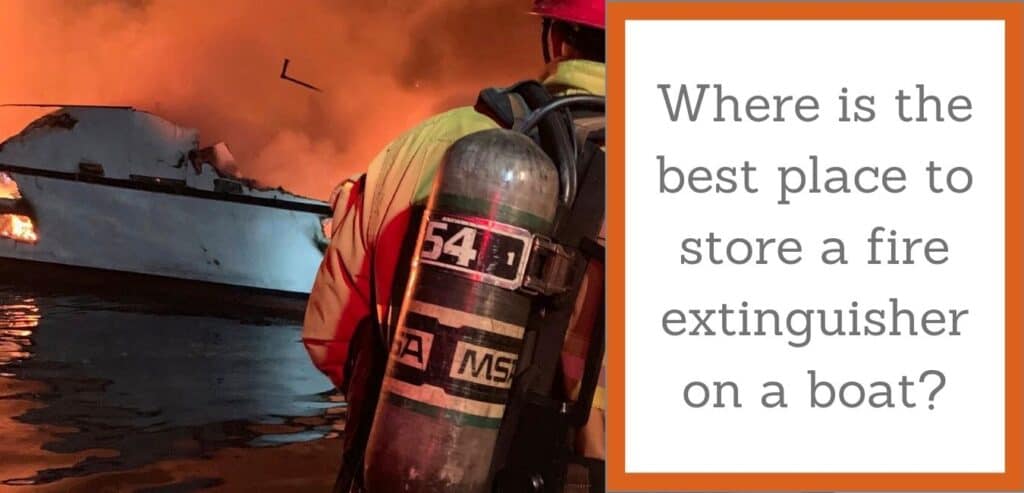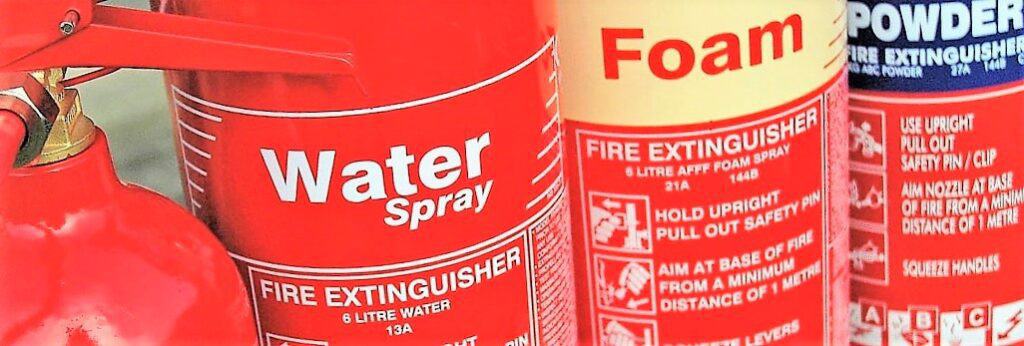
Picture this:
You’ve decided to take your family on a cruise trip, all you want is to have a good time. Everything is going on well until a fire breaks the party!
Everyone is running all over the place, and it is all chaos. You cannot trace the fire extinguishers, and the fire progresses quickly.
Although surrounded by a mass of water, that doesn’t seem to help!
By the time you manage to put it out, the damage caused is beyond repair, and some people are injured. More importantly, the loss of life for example in this California boat is beyond regret.
So, where exactly should you place a fire extinguisher in a boat?
A lot of people are asking, “where is the best place to store a fire extinguisher in a boat?”
But first, let’s get to understand the different types of fire extinguishers.
Contents
Get the Right Fire Extinguisher for your Boat!
Fire extinguishers have ratings as either A, B, C, D, or K depending on the type of fire it can put out. All fires aren’t the same, and it’s paramount to understand what fire extinguisher works where.
Usually, the fire extinguishers have a label on the side of the tank.

Type A Fire Extinguisher
A fire extinguisher classified as type A puts out fires that start from the trash in the boat, wooden beams, or ash.
These fires are easily put out using water and foam or a mixture of the two. Type A fires are the most common in boats.
Type B Fire Extinguisher
Class B fires start from barrels of gasoline, petroleum, paint, and other highly flammable oils and gases. If you’re aboard a vessel burning from oils or gases, don’t make the mistake of using water to extinguish it.
Notably, water has a lower boiling point than most oils and gases. Therefore, if you try putting the fire out using water, it will evaporate, leaving steam, which can accelerate the fire or even burn you.
Class B fires are put out using dry powder, halogen, ammonium phosphate, carbon dioxide, or foam.
Type C Fire Extinguisher
Electric faults cause class C fires. For these fires, you want to make sure that you use a fire extinguisher filled with carbon dioxide or other dry chemicals.
As you put out the fire, make sure not to use water because we all know water is a good electricity conductor.
Class C fires are also very common in boats.
Type D Fire Extinguisher
Class D fires are rare in boats because they mainly start from flammable metals such as titanium and magnesium.
For these types of fires, you want to make sure you use dry chemicals in your fire extinguisher.
Type K Fire Extinguisher
Type K fires start from the kitchen. It’s not uncommon for boats to have small kitchens and which are prone to fire outbreaks.
The fires are triggered by cooking oils, fats, and grease. These fires are notorious for causing explosions that can quickly spread to other areas of the boat.
To put out class K fires, you want to make sure you use dry chemicals, halogen, pressurized carbon dioxide, ammonium phosphate, or foam.
Now that we know the different fire classifications let’s find out where to keep the fire extinguishers for easy access.
Boat Fire Extinguisher Requirements
As a minimum requirement, you need to have a B-1 fire extinguisher in your boat if your boat is smaller than 26 feet. If your boat is bigger than this, you need to have at least 2 B-1 fire extinguishers.
Here is a table summarizing the legal requirement of fire extinguishers in a boat.
| Boat Size | Without a fire extinguishing system | With a US Coast Guard Fire system |
|---|---|---|
| Less than 26 feet | 1 B-1 fire extinguisher | None |
| 26 to 40 feet | 2 B-1 fire extinguishers | 1 B-1 fire extinguisher |
| 40 to 65 feet | 3 B-1 fire extinguishers | 2 B-1 fire extinguishers |
If you have a US Coast Guard fire extinguisher system installed within your vessel, then you may not need many fire extinguishers.
Probably you’re wondering who can get the US Coast Guard fire extinguisher system. Here is the checklist.
- Installed fuel tanks
- Enclosed cooking areas
- Parts of the boat don’t have flotation materials
- Presence of engine tanks in the seat areas
- Engine compartments that are fully enclosed
- Unsealed double bottoms
Best Place to Mount a Fire Extinguisher in a Boat
The best answer to where you should place a fire extinguisher in a boat is, “it depends.” There are several factors to consider, but as a general rule of thumb, the area should be easily accessible in an emergency.
Consider the following:
Where do people spend most of the time?
Depending on where you and the other passengers spend most of their time, the fire extinguishers should be within an arm’s reach.
Where can a fire start?
Usually, a fire is most likely to break out from areas with flammable gases, the kitchen, or the engine compartment. Now, you want to make sure that you place fire extinguishers close to these areas.
In as much as you ought to place fire extinguishers close to fire-prone areas, you want to make sure they aren’t so close that you cannot safely access them in the event of a fire.
In a Nutshell
It’s always important to be prepared for fire outbreaks, especially in boats, because you need to save yourself before getting professional help.
Boat fires mainly start from the kitchen, engine compartments, and fuel storage. The best place to store fire extinguishers in a boat is in areas where passengers spend the most time and near the areas where a fire is likely to start.